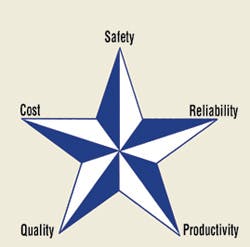Myth #7: High Quality Must Sacrifice Quantity
Historically, management and engineering viewed issues of high production quantity and high quality as diametrically opposed. This double-Q dilemma maintains that if product quality is paramount, then production rates must suffer, resulting in lower quantity. However, if production is stepped up, scrap must increase, and quality generally, must suffer.
But there are implications beyond this simple double-Q quandary. If processes are accelerated, production machinery becomes noisy, less reliable, and produces inconsistent parts or services — not to mention the increased down time due to overstressed machine members and parts. Management was in a constant struggle to increase production for maximum profits, but without the risk of alienating good customers. Such was the double-Q dilemma, but no more!
The motion control solution
Motion control technology was developed specifically to address and defeat the double-Q dilemma. With motion control technology you can increase speed and increase both product quality and consistency. Machines can operate faster, with higher reliability, less noise, and achieve longer life. Furthermore, with reduced machine stress levels and noise, safety for both man and machine are improved. And, of course, with higher productivity, greater quality, and higher reliability, operating costs are lower, so profits go up. The benefits also help build customer loyalty because more predictable and reliable production allows justin- time-inventory methods.
The designer can use motion control to take total and complete control of the machine. No motion is left to chance. The machine is “guided by the nose” from cradle to grave, from inception to resurrection. The motion control star represents the idea that motion control technology eliminates the mutual exclusivity of the double-Q dilemma, and instead, creates mutual inclusivity in not only quality versus quantity, but in other performance capabilities as well.
Motion control technology is not a separate academic discipline, such as integrated circuit design and manufacturing, computer architecture, or electrical engineering. Instead, it is a convergence of many existing, but diverse, technologies to solve systemic problems of all types.
The purpose here is to present an overall view of the technology and, in the process, cover the constituent technical disciplines to make you more aware of motion control and what is needed in order to be successful in it.
Elements of motion control
Motion control encompasses hydraulic, pneumatic, and electromechanical technologies. However, the focus of this column hydraulics. Hydraulic actuation provides the power needed to move the load. The diversification taking place at both the distribution and manufacturing levels has brought integrated electromechanical components into motion control systems that traditionally had been all hydraulic. As more designers recognize the need for the “optimum solution” to motion control problems, more suppliers now offer product lines that include hydraulic, pneumatic, and electrical actuation methods.
Interestingly, it is the actuator that separates the hydraulic motion control system from the electric. To some extent, the sensors are unique, but the separation really is dictated by the selection of the actuation method. The rest of the system elements are common from one actuation medium to another.
Analyzing the load
Load analysis is one of the more challenging elements of motion control technology. Any useful motion control system will move a load. The load may be constant, for example in the case of a flying cutoff. Or it may vary considerably, as with robot axes and elevators. It may not be clear to the uninitiated, but the load is “inside the control loop.” The load seriously affects all aspects of motion control performance.
Newcomers to the technology have too often been burned by having the first installation go well because the actuator had a light load, but disaster struck with the next application because the load was severe. The load must be taken into account if, for no other reason than to determine the extent to which it dominates, potentially limiting the performance of the motion control axis.
Analog and digital signals
There is no denying that motion control contains a strong electronic element. The electronic element must include both analog and digital components. First, sensors are mostly analog, and the fluid power and electromechanical actuation devices certainly are all analog. But the motion controller itself, more often than not, is a digital computer of some sort. It may be an industrial PC, but, more likely, it will be a programmable logic controller (PLC).
In the high performance arena, the PC or PLC will be fitted with a dedicated motion control card using a digital signal processor (DSP) that provides the speed needed to service one or more servo loops. However, at least one manufacturer offers the inverse of this — a motion controller with an auxiliary PLC.
Integral with the motion controller card will be analog-to-digital converters (A/Ds) and digital-to-analog converters (D/As). Additionally, sensors will have signal conditioners, special purpose amplifiers to drive the coils on servo/proportional valves, and communications bus link-ups as industry increasingly “gets wired” into enterprise-wide networks.
Software plays an increasing role, because every digital device needs some kind of program to run. This is true of the PC, PLC, motion controller, and data acquisition card. Unfortunately, the programming of motion controllers is a proprietary endeavor. All card designers and manufacturers have developed their own instruction sets and have made no attempt to create a universal motion control language. In fact, different product lines within a single company can have different instructions. The user may have to learn a different set of instructions for each different card.


